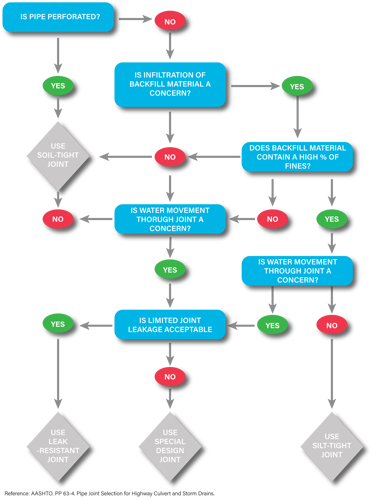
Quick Guide to Joint Types for Sewers and Drainage
There are a whole lot of different types of pipes and pipe joints used in the civil engineering industry. This blog will focus on those associated with sanitary sewer, storm sewer and drainage applications. What are the different ratings? How are they defined? How are they quantified or tested? All good questions. I will be referencing mostly from the American Association of State Highway and Transportation Officials (AASHTO) and AASHTO PP 63-09, Pipe Joint Selection for Highway Culvert and Storm Drains.
AASHTO PP63 is a good resource, but it requires some handholding when using it. There are six joint types defined and four joint types categorized by description, lab testing and field testing. I will start with the six types defined.
- Leak-resistant joint – joint that limits water leakage at a maximum rate of 200 gallons/inch-diameter/mile/day. (Typical for culverts, drainage and storm sewers)
- Restrained joint – joint used for applications subject to significant tensile and shear forces and moments. Examples: high slopes, differential settlement, high pressure, or high velocities.
- Silt-tight joint – joint that is resistant to infiltration of particles that are smaller than particles passing the No. 200 sieve. They provide protection against infiltration of backfill containing a high percentage of fines, and typically use a rubber seal or gasket. (Typical for gravity irrigation, culverts, and drainage applications)
- Soil-tight joint – joint that is resistant to infiltration of particles larger than those retained on the No. 200 sieve. They provide protection against infiltration of backfill containing a high percentage of coarse grain soils. (Typical for gravity irrigation, culverts, and drainage applications)
- Special design joint – joint requiring special strength in bending or shear, pull-apart, or unusual features such as a restrained joint (severe slopes, welded joints, flanged, high pressure, high velocities, etc.).
- Watertight joint – joint that provides zero leakage of water infiltration and exfiltration for a specified head or pressure application. Watertight joints typically utilize a resilient rubber seal of some type and are capable of passing a laboratory hydrostatic pressure and vacuum test of at least 10.8 psi without leakage. (Typical for Sanitary Sewers)
The four joint types that are further categorized and used in the decision tree below include: Soil-tight, Silt-tight, Leak-resistant and Special design joints. The specification further describes the plant (lab) and field testing requirements for these joint types for Reinforced Concrete Pipe, Corrugated Metal Pipe and Plastic Pipe (e.g. PVC and HDPE).
It is essential to understand the performance differences and features of a pipe product being considered for any given application. AASHTO PP-63 provides some guidance and definition to the various types of joints offered in the industry as well as testing methods. Using the below flow chart can help make joint decisions as they would relate to a given site condition and application.

